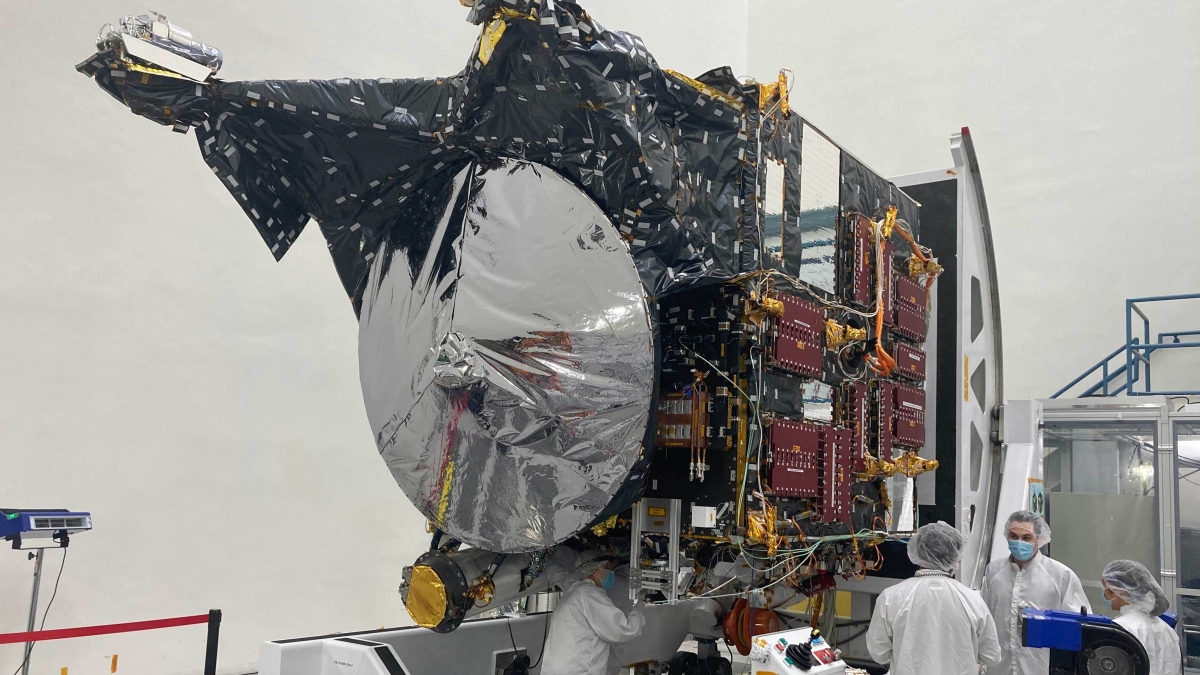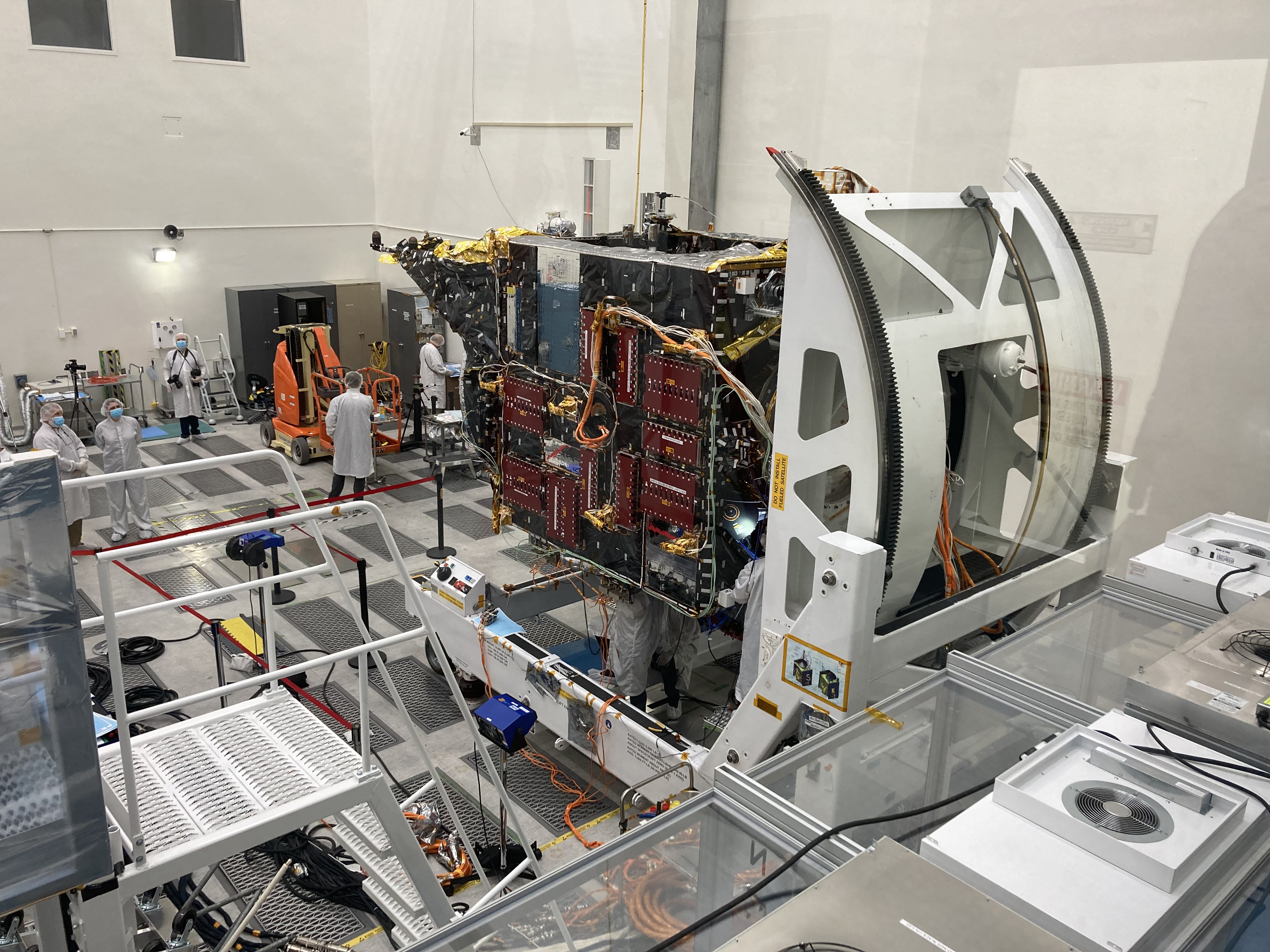Editor's note: On June 24, 2022, NASA announced that the Psyche mission will not make its planned 2022 launch attempt due to the need for more time to ensure that the spacecraft’s flight software and testing equipment will function properly in flight. A new launch period has since been announced: Oct. 5-25, 2023.
PASADENA, Calif. – It’s just before 9:30 a.m. when you arrive at NASA’s Jet Propulsion Laboratory.
You’re here to see the Psyche spacecraft, which is in its final stages of testing before being flown to NASA’s Kennedy Space Center.
You sign in, receive your media badge and are handed a printout titled “Clean Room Rules/Logistics.” The rules are designed to make sure not a single loose strand of clothing or dust particle somehow finds its way onto the spacecraft’s inner workings and instruments.
You can’t bring a notebook or writing utensil into the clean room. You can’t wear makeup or any frayed clothing. Most of your skin must be covered, and you cannot wear jewelry with sharp edges.
After a few minutes, you and the other media members pile into a white van and are driven to the entrance to the clean room, where Psyche is located.
But you’re not in yet.
In an outside room, you’re told to place your feet, one at a time, into a brushing machine that cleans the bottom of your shoes. Your cellphone or camera is wiped down. You’re given a smock, booties, a mask, hairnet and gloves to wear.
Finally, properly fitted and vetted, you walk through the air lock and into the clean room. There it is: Psyche.
And standing nearby, a smile evident even under her mask, is Lindy Elkins-Tanton, the principal investigator for the Psyche mission, Regents Professor in Arizona State University’s School of Earth and Space Exploration and vice president of ASU’s Interplanetary Initiative.
Elkins-Tanton is smiling because the day is almost here. In late April, the Psyche spacecraft — which will be approximately the size of a singles tennis court after its huge solar panels unfold in space — will be flown to Kennedy Space Center in Florida, where it will undergo final preparations for its scheduled launch in August and 3 1/2-year journey to the asteroid Psyche.
“It does feel surreal to me,” Elkins-Tanton said. “But I’m trying really hard not to count my chickens. I was giving a talk to a bunch of high schoolers a couple of years ago, and one of them said to me, ‘What if it blows up on the launch pad?’ First of all, I was like, ‘How can you say those words?’ He goes, ‘Do you get a do-over?’ And I’m like, ‘No, we don’t get a do-over.’
“It’s such a high-risk endeavor, so I try to really just enjoy every day and not count on exactly what’s coming next. So, it’s hard for me to be over the moon. Yes, we’re about to launch, but there’s still a lot of days between now and then.”
Still, Elkins-Tanton said, the impending flight of Psyche is “an important milestone to celebrate.”
She has been working on the mission for 11 years. There have been stops and starts and questions and answers, and although there is still much that can go wrong — it’s the nature of a space mission — Elkins-Tanton and her team are at the point where they can feel confident about the launch and mission. They completed their final hardware and instrument testing last Saturday, and the remaining software testing and mission operational tests will be performed at testbeds at JPL and on the flight vehicle between now and launch.
“Honestly, it feels like a lot of relief,” said Brian Bone, Psyche’s assembly test and launch operations manager at JPL. “Knowing the spacecraft is ready and the last little step is kind of upon us is unbelievable. It’s gone through all of the system tests. It’s gone through all of its key functional testing. Its ready to ship to the cape in preparation for launch.”
Another view of the Psyche spacecraft in the JPL clean room. The mission team completed final hardware and instrument testing last Saturday, and the remaining software testing will be done before the late-April departure to Florida. Photo by Scott Bordow/ASU News
Bone is asked about the clean room rules, and why it’s vital to avoid even a single dust particle. If a particle settles on the spacecraft’s cameras, called the Psyche Imagers — principal investigator of that instrument team is Jim Bell of ASU’s School of Earth and Space Exploration — it could potentially cloud or obscure the images they take of the asteroid.
“We have to protect those images,” he said. “Now that the cameras are installed, any particle that finds its way onto the lenses we may not actually see until we take that first picture in flight, and then there’s nothing we can do about it.”
Once Psyche arrives in Florida, its solar panels will be installed. The days will be counted down until the launch period opens on Aug. 1.
Then, after liftoff, the long wait begins.
The spacecraft’s cameras will be able to see the asteroid — which is the shape of a potato and about the size of the state of Massachusetts — as a point of light during the entire cruise phase; starting near the end of 2025, it will start slowly getting larger to the onboard cameras, Bell said.
Henry Stone, Psyche’s project manager at JPL, said once the asteroid is close enough that it can easily be seen by the cameras, the mission operations team will adjust the trajectory of the spacecraft and bring it into orbit.
Psyche will not land on the asteroid; but as it orbits, its objective is to determine, among other things, whether the asteroid is leftover core material of an early planetesimal (a building block of planet formation) or simply unmelted material.
“If it is a core, which is the leading hypothesis, that’s going to be just tremendous in pinning down which models best explain how the solar system was formed,” Stone said.
That’s the dream. On Monday, as media took pictures of the spacecraft and Elkins-Tanton did interviews, the reality was settling in: Psyche will soon be on its way to Florida. On its way to the launch pad. On its way to the Psyche asteroid.
“We’re going to have 3 1/2 years in space, and then we’re going to have almost two years at the asteroid,” Elkins-Tanton said. “But it’s those key milestones where you say to everyone, ‘Great job. Look what we’ve done.’ And I feel like this is one of them.”
About the NASA Psyche mission
ASU leads the Psyche mission as the home of the mission's principal investigator, Lindy Elkins-Tanton. NASA's Jet Propulsion Laboratory, a division of Caltech, is responsible for the mission's overall management, system engineering, integration and testing, and mission operations. Maxar Technologies delivered the solar electric propulsion chassis, the main body of the spacecraft and most of its engineering hardware systems. NASA's Launch Services Program at Kennedy Space Center manages launch operations.
For more information about NASA's Psyche mission, go to www.nasa.gov/psyche and psyche.asu.edu/
Top photo: The Psyche spacecraft is shown in its clean room at NASA’s Jet Propulsion Laboratory in Pasadena, California, on Monday, April 11. Members of the media were invited to get a last close-up look at the spacecraft before it is flown to Florida for final launch preparations. The launch period opens Aug. 1. Photo by Scott Bordow/ASU News
More Science and technology

ASU technical innovation enables more reliable and less expensive electricity
Growing demand for electricity is pushing the energy sector to innovate faster and deploy more resources to keep the lights on and costs low. Clean energy is being pursued with greater fervor,…

What do a spacecraft, a skeleton and an asteroid have in common? This ASU professor
NASA’s Lucy spacecraft will probe an asteroid as it flys by it on Sunday — one with a connection to the mission name.The asteroid is named Donaldjohanson, after Donald Johanson, who founded Arizona…

Hack like you 'meme' it
What do pepperoni pizza, cat memes and an online dojo have in common?It turns out, these are all essential elements of a great cybersecurity hacking competition.And experts at Arizona State…



